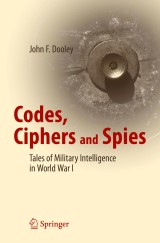Details

Codes, Ciphers and Spies
Tales of Military Intelligence in World War I|
32,09 € |
|
| Verlag: | Copernicus |
| Format: | |
| Veröffentl.: | 31.03.2016 |
| ISBN/EAN: | 9783319294155 |
| Sprache: | englisch |
Dieses eBook enthält ein Wasserzeichen.
Beschreibungen
<p>When the United States declared war on Germany in April 1917, it was woefully unprepared to wage a modern war. Whereas their European counterparts already had three years of experience in using code and cipher systems in the war, American cryptologists had to help in the building of a military intelligence unit from scratch. This book relates the personal experiences of one such character, providing a uniquely American perspective on the Great War. It is a story of spies, coded letters, plots to blow up ships and munitions plants, secret inks, arms smuggling, treason, and desperate battlefield messages. Yet it all begins with a college English professor and Chaucer scholar named John Mathews Manly.</p><p>In 1927, John Manly wrote a series of articles on his service in the Code and Cipher Section (MI-8) of the U.S. Army’s Military Intelligence Division (MID) during World War I. Published here for the first time, enhanced with references and annotations for additional context, these articles form the basis of an exciting exploration of American military intelligence and counter-espionage in 1917-1918. Illustrating the thoughts of prisoners of war, draftees, German spies, and ordinary Americans with secrets to hide, the messages deciphered by Manly provide a fascinating insight into the state of mind of a nation at war.</p><p></p>
<p>An Introduction and a Few Words on Codes and Ciphers</p><p><b>PART I: The AEF</b></p><p>The Americans Embark: Getting to France 1917 – 1918</p><p>Introduction to Communications, Codes, and Ciphers in the AEF</p><p>The AEF and Colonel Moorman</p><p>Cryptology at the Front</p><p>The AEF: Breaking Codes and Ciphers</p><p>The AEF: German Codes and Ciphers</p><p>The AEF Fights: 1918</p><p><b>PART II: MI-8 and the Home Front</b></p><p>MI-8 and Civilian Messages</p><p>Civilian Correspondence: Foreign Letters and Hoaxes</p><p>Civilian Correspondence: Prisoners and Spies</p>Civilian Correspondence: Families and Love Letters<p></p><p><b>PART III: German Spies in America, 1914 – 1918</b></p><p>Spies Among Us: The New York Cell, 1914 – 1915</p><p>Spies Among Us: Baltimore, Germs, Black Tom, and Kingsland, 1916 – 1917</p><p>The Waberski Cipher: A Spy is Condemned</p><p>Madame Victorica Arrives in New York</p><p>Madame Victorica and German Agents in the U.S.</p><p>More German Spies</p><p>Madame Victorica and Invisible Inks</p><p>Madame Victorica – Captured!</p><p><b>Part IV: Epilogue</b></p><p>Epilogue</p><p></p>
John F. Dooley is the William and Marilyn Ingersoll Professor of Computer Science at Knox College in Galesburg, Illinois. Before returning to teaching in 2001, he spent more than 15 years in the software industry as a developer, designer, and manager working for companies such as Bell Telephone Laboratories, McDonnell Douglas, IBM, and Motorola. Since 2004 his main research interest has been in the history of American cryptology, particularly during the inter-war period. His previous publications include the Springer titles A Brief History of Cryptology and Cryptographic Algorithms and Software Development and Professional Practice.
When the United States declared war on Germany in April 1917, it was woefully unprepared to wage a modern war. Whereas their European counterparts already had three years of experience in using code and cipher systems in the war, American cryptologists had to help in the building of a military intelligence unit from scratch. This book relates the personal experiences of one such character, providing a uniquely American perspective on the Great War. It is a story of spies, coded letters, plots to blow up ships and munitions plants, secret inks, arms smuggling, treason, and desperate battlefield messages. Yet it all begins with a college English professor and Chaucer scholar named John Mathews Manly.<p></p><p>In 1927, John Manly wrote a series of articles on his service in the Code and Cipher Section (MI-8) of the U.S. Army’s Military Intelligence Division (MID) during World War I. Published here for the first time, enhanced with references and annotations for additional context, these articles form the basis of an exciting exploration of American military intelligence and counter-espionage in 1917-1918. Illustrating the thoughts of prisoners of war, draftees, German spies, and ordinary Americans with secrets to hide, the messages deciphered by Manly provide a fascinating insight into the state of mind of a nation at war.<br></p><p><b>John F. Dooley </b>is the William and Marilyn Ingersoll Professor of Computer Science at Knox College in Galesburg, Illinois. Before returning to teaching in 2001, he spent more than 15 years in the software industry as a developer, designer, and manager working for companies such as Bell Telephone Laboratories, McDonnell Douglas, IBM, and Motorola. Since 2004 his main research interest has been in the history of American cryptology, particularly during the inter-war period. His previous publications include the Springer titles A Brief History of Cryptology and Cryptographic Algorithms and Software Development and Professional Practice.</p>
<p>Provides a timely addition to scholarship in the area, at the approach of the 100th anniversary of American participation in WWI</p><p>Presents many interesting stories on the work of MI-8 on the home front, on the AEF in France, and on the cryptographic work of G2.A6</p><p>Describes a fascinating set of characters and tales from the history of German spies and sabotage in the US during the war</p><p>Includes supplementary material: sn.pub/extras</p>

















